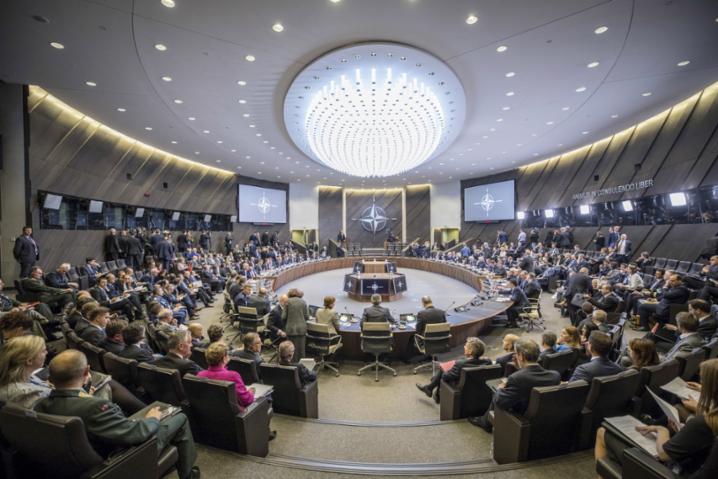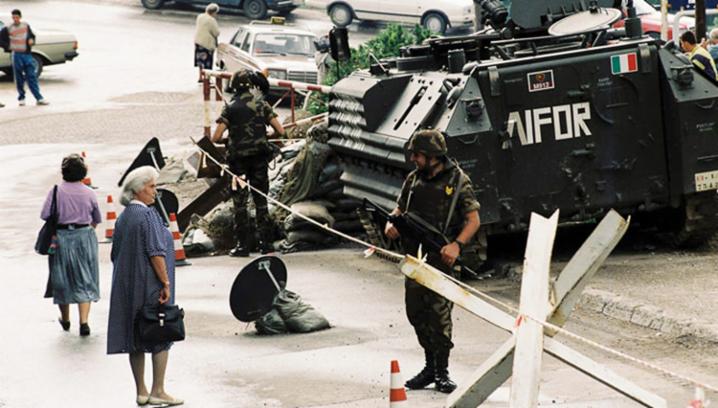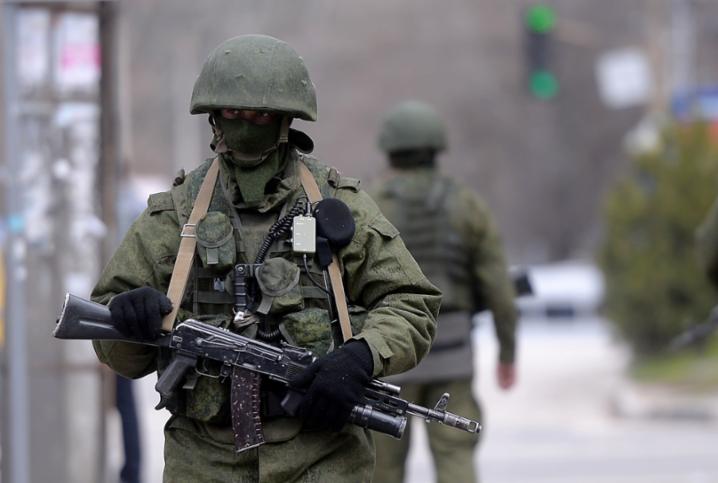What is the role of crisis management exercises? How have they evolved within NATO? Is the current international security environment influencing how these exercises are planned and conducted?

NATO crisis management exercises allow the Alliance to rehearse and test its internal and partner consultation and decision-making procedures at the strategic political-military level. They involve civilian and military staffs in Allied capitals, at NATO Headquarters and in both Strategic Commands. Pictured: general view of a meeting of the North Atlantic Council. © NATO
For a brief moment back in May 2019, NATO was in the depths of a major crisis. Not a real one, but a simulation aimed at testing the Alliance’s crisis management arrangements at the strategic political-military level. Held between 9 and 15 May 2019, Crisis Management Exercise 2019 was one of NATO’s largest political-military exercises since the series was created in 1992, drawing together more than 2,000 participants from across the Alliance.
This level of participation illustrates just how much momentum strategic political-military exercises have gained in recent years within NATO and other international organisations, including the European Union. Under the Common Security and Defence Policy, the latter has organised several large-scale crisis management exercises since May 2002 to test the different layers of its crisis response processes. More recently, in September 2017 and November 2018, the European Union has held two parallel and coordinated exercises on responses to complex hybrid emergencies, together with NATO.
Historical evolution
Though they have become particularly visible in recent years, strategic political-military exercises have a long history within the Alliance, dating back to the early days of the Cold War. While they have significantly evolved over this period, the rationale for organising them has always reflected the Alliance’s priorities and concerns at a given time.
From the outset, NATO’s political-military exercises were designed to exercise the Alliance’s deterrence and defence arrangements, including collective defence under Article 5 of the Washington Treaty. Indeed, in the period from the 1950s to 1989, these exercises mirrored the Alliance’s concern for the conventional threat posed by the Soviet Union and the other Warsaw Pact members.
Developed in the early days of the Cold War, FALLEX (Fall Exercise) constituted NATO’s main high-level exercise. It was replaced by the biennial WINTEX-CIMEX (Winter Exercise and Civil-Military Exercise) in odd years between the mid-1960s and late 1980s, and by the HILEX (High-Level Exercise) in even years throughout the 1980s. WINTEX-CIMEX was a comprehensive two-week kinetic and reinforcement exercise covering strategic, operational and tactical levels in all three domains – land, maritime and air – using standing forces deployed across Western Europe, with a tactical nuclear dimension. HILEX, on the other hand, was an internal NATO Headquarters-based staff training exercise aimed at maintaining procedural awareness and an understanding of the collective defence security environment of the Alliance.
In 1989, the fall of the Berlin Wall ushered in a new era for NATO’s political-military exercises. The demise of the Warsaw Pact led NATO to carry out a major revision of its framework for these exercises, with the last WINTEX-CIMEX taking place in 1989 and the last HILEX ending shortly beforehand. Over the next two decades, the exercises’ sole focus on collective defence decreased, as the perception of a threat coming from the East was replaced by growing concerns over asymmetric challenges and instability on the Alliance’s periphery.
The first official NATO exercise bearing the name “crisis management exercise” was launched as a pilot project in 1992. Held as a week-long exercise, it aimed at testing crisis management roles and procedures at the staff and command levels. The focus was on increasing NATO’s ability to respond to crises within the post-Cold War environment, which was characterised by higher uncertainty and improving East-West relations.

During the 1990s, against the backdrop of the NATO-led peace support operations in the Western Balkans, NATO crisis management exercises started to focus on scenarios involving crisis response operations outside its borders. Pictured: Implementation Force (IFOR) in Bosnia and Herzegovina in December 1995. © NATO
During the 1990s, NATO’s military intervention in the Western Balkans provided a strong catalyst for the Alliance to focus crisis management exercises on non-Article 5 crisis response operations outside its borders, including NATO-led peace support operations mandated by the United Nations. After the tragedies in Rwanda and the Western Balkans, the international community began to see interventions as legitimate means to prevent large-scale violation of human rights. This was reflected in the development of new concepts, including the so-called “Responsibility to Protect”.
During this period, crisis management exercises came to be seen as useful tools to practise decision-making in relation to conflict prevention and resolution, or in the pursuit of humanitarian objectives. The 2001 intervention in Afghanistan provided additional incentives for Allies to exercise these concepts, together with the challenges arising from terrorism and asymmetric conflict. NATO also started to include partners and international organisations within its crisis management architecture, with crisis management exercises serving as useful vectors for introducing external entities to the work of the Alliance.
Since 2014, following Russia’s illegal annexation of Crimea, changes in the global security environment have renewed NATO’s interest in exercising collective defence. By raising the spectre of conventional warfare, the resurgence of a threat from the East provided a new impetus for the reassessment of NATO’s exercising priorities, expanding crisis management exercises in scope to include both Article 5 (collective defence) and non-Article 5 (projecting stability) scenarios. Today’s crisis management exercises are increasingly complex, mirroring the wide array of security challenges and potential crises the Alliance must respond to in its current security environment: from hybrid to potential kinetic warfare, to terrorism, to instability outside the Alliance’s borders, to the spread of weapons of mass destruction. These changes have also led NATO to move from purely fictitious scenarios, to scenarios using increasingly realistic settings.
Prepare, test, adapt
Crises can be unexpected and sometimes unforeseeable events, which challenge the fundamental values and norms of a system, and call for the coordination of many different actors and urgent decision-making. Government and international organisations have historically played an important role in crisis management. In times of crisis, citizens often look to policymakers to mitigate the adverse consequences of an emergency, be it political, economic or social – and failure to respond adequately can cause irreparable damage to an organisation’s image and legitimacy.
Yet crises have also significantly evolved in today’s complex security environment. Increasing trans-nationalisation, globalisation and mediatisation, as well as spectacular advances in information and communication technologies have led to new forms of challenges (for example, hybrid and cyber) that undermine more “traditional” notions of crisis management. This makes it harder for governments and international actors alike to identify the warning signs of a materialising emergency, or predict their effects beyond immediate short-term consequences. In this changing landscape, crisis management exercises are re-emerging as powerful tools for decision-makers and organisations to enhance their ability to deal with the advent of disruptive and often unexpected events.

The appearance of ‘little green men’ and Russia’s illegal annexation of Crimea in March 2014 marked a significant shift in the security environment. Today’s crisis management exercises are increasingly complex, mirroring the wide array of security challenges and potential crises facing NATO. © Quora.com
One of the crucial benefits that organisations like NATO can derive from crisis management exercises, especially today, is an increase in strategic culture, risk awareness and preparedness. In large international organisations, staff structures are often marred by remarkably high levels of staff turnover, which can lead to a lack of crisis management experience and training, and undermine preparedness at the individual and organisational levels. At the same time, few opportunities exist to actually learn crisis management from first-hand experience.
By offering safe and controlled environments in which participants can measure their ability to confront a given situation, crisis management exercises can help ensure participants are equipped with the appropriate skills and knowledge to address future disruptive events. Even if the parameters of a real crisis will always differ from those of a controlled exercise, they remain effective venues for increasing the level of preparedness and risk awareness across NATO, for instance by helping participants better understand the driving factors or early-warning signs of an emerging crisis situation, and ultimately to prepare for the unknown.
Crisis management exercises can also serve as vehicles to assess the strengths and weaknesses of an organisation’s crisis management capabilities. A crisis management exercise can help identify what works and – perhaps most importantly – what fails in the roles, plans and procedures designed to respond to a wide range of crisis scenarios. This is one of the most cost-effective and tangible ways of ensuring that arrangements that have been put in place during peacetime are working properly to address the full spectrum of a crisis – before, during and after a disruptive event. Crucially, they offer tools to test and evaluate new and evolving concepts in a context where mistakes are admitted, and controlled risk is encouraged.
To be truly meaningful, however, an exercise should be part of a process of change in which problems that arise are transformed into opportunities for improvement. The identification of lessons and remedial actions through the evaluation of NATO’s overall response is indeed an essential aspect of any crisis management exercise. This aims at capturing and correcting any gaps, mistakes and deficiencies, or at determining strengths in all areas of crisis management, from deterrence and defence, to operational planning, to situational awareness, to cyber defence, to partner cooperation and beyond. Timing is critical. An effective review requires that discussions take place while the exercise is still fresh in the minds of decision-makers and participants.
Finally, crisis management exercises are social processes. By fostering discussion, these exercises can help forge a shared vocabulary about a given crisis and the means to address it, thus creating a sense of unity and shared purpose. They bring together the otherwise disparate crisis management community from NATO Headquarters, Allied capitals, strategic commands and partner countries to discuss and generally agree on the conclusions of an exercise, and on the factors that will help mitigate any identified challenges. At a basic level, they constitute opportunities for networking and for developing new contacts from across sectors, including with international organisations and partners. Of course, exercises may also generate friction and unveil intra-Alliance divisions on key sensitive issues. But by providing a framework for dialogue, including through Article 4 consultations, these exercises can also serve as useful venues for overcoming such differences. Indeed, it is far better to address these challenges in the controlled environment of an exercise than in the heat of a real crisis.
The future: tapping into new technologies
The development of new technologies is one of the most exciting trends in the field of crisis management exercises today. With the advent of artificial intelligence and advanced modelling and simulation techniques, tomorrow’s crisis management exercises are likely to be more immersive, interactive and dynamic than ever. These technologies will allow future exercises to better replicate real-life parameters and allow for multiple scenarios to play out depending on the decisions taken by participants, thus maximising their training potential.
While it may take years before such technologies revolutionise the way exercises are designed and conducted, some have already started to have a transformative impact on exercises at the operational and tactical levels, for instance on the way air force pilots are taught and trained. With these advances promising to further increase their added value, crisis management exercises are likely to remain key tools in the future for the Alliance to prepare against the risks of tomorrow’s complex security environment.
